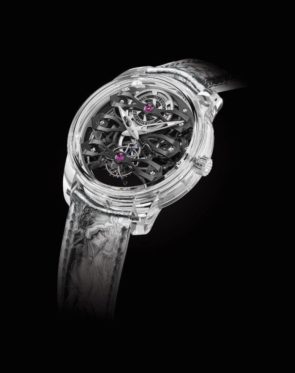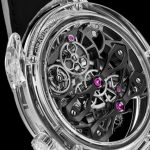At Watches & Wonders 2019 in Miami, Girard-Perregaux presented the new Quasar. The spectacle of the new Neo-Tourbillon movement with Three Bridges is fully revealed to the eye thanks to a case made entirely of sapphire crystal. Exactly one year ago, Girard-Perregaux presented the Neo-Tourbillon with Three Bridges Squelette. Today, the Swiss watchmaker is presenting the new Quasar, a timepiece offering a new dimension to this iconic movement. Under the auspices of the "Earth to Sky" theme, this complicated piece is named after the brightest of astronomical entities, the quasar to be precise. Thus illuminated, this tourbillon with a modern soul enters the light spectrum with its case made entirely of transparent sapphire crystal. Through these crystalline walls, the GP9400-1035 calibre reveals its skeletonised volumes. The Quasar naturally applies four principles of the Girard-Perregaux universe. The first is the 1884 patent on the three gold bridges visible on the side of the dial, the unmistakable signature of the Maison. The second is the manual skeletonisation carried out at the workshops in La Chaux-de-Fonds. The third is the birth, in 2015, of the Neo-Tourbillon With Three Bridges. The latter were neither straight nor gold, but arched, skeletonised and black. The fourth is the use of sapphire in a more technological role than just glass. With the 2007 Laureato Con Tre Ponti Zaffiro, the corundum crystal had found a place within the very structure of a Haute Horlogerie calibre. All four of these factors contribute to the creation of the Quasar. At 45 mm in diameter, the case of the Quasar is made entirely of sapphire crystal. A glass rod wraps around the movement bridges like a telluric dome. The carrure is in one piece, rounded on the sides and angular at the lugs. At almost 3,000 degrees Kelvin, the fundamental particles melt under the pressure of an incandescent flow of oxygen and hydrogen. It is from this process that sapphire glass is born. Next, the material is sculpted, filed, drilled, domed and polished with the aid of instruments using the hardest material in the universe: diamond. TheGP9400-1035 calibre used is an evolution of the 9400 calibre aimed at making the plate disappear. The movement is found in 'levitation', as if it had a vacuum around it. Only the physically indispensable anchor points remain, as in a demonstration of aeronautical technology. The bridges make a visual contribution to the Quasar's overall effect of transparency. They are made of titanium, sandblasted and finally blackened with a PVD treatment. In three dimensions, their outline is of such complexity, with its recessed angles, arches, bevels and protrusions, that the workmanship is a marvel of watchmaking art.
Girard-Perregaux Quasar - Data Sheet
Reference: 99295-43-000-BA6A
Case
- Material: sapphire glass.
- Diameter: 45 mm.
- Glass: anti-reflective sapphire.
- Dial: absent.
- Hands: skeleton, white gold, 'Dauphine' type with Superluminova.
- Back: sapphire crystal.
- Water resistance: 30 metres (3 ATM).
Movement
- Reference: GP09400-1035.
- Charging: automatic.
- Functions: tourbillon, hours, minutes, small seconds with tourbillon.
- Power reserve: 60 hours.
- Number of components: 260 of which 27 are rubies.
- Diameter: 36.00 mm (16 lines).
- Frequency: 21,600 alt./hour (3 Hz).
- Thickness: 9.54 mm.
Tourbillon
Tourbillon cage consisting of 80 pieces, with a total weight of just 0.250 grams.
Strap
- Material: hand-stitched alligator in black.
- Buckle: triple-blade folding buckle in titanium.





